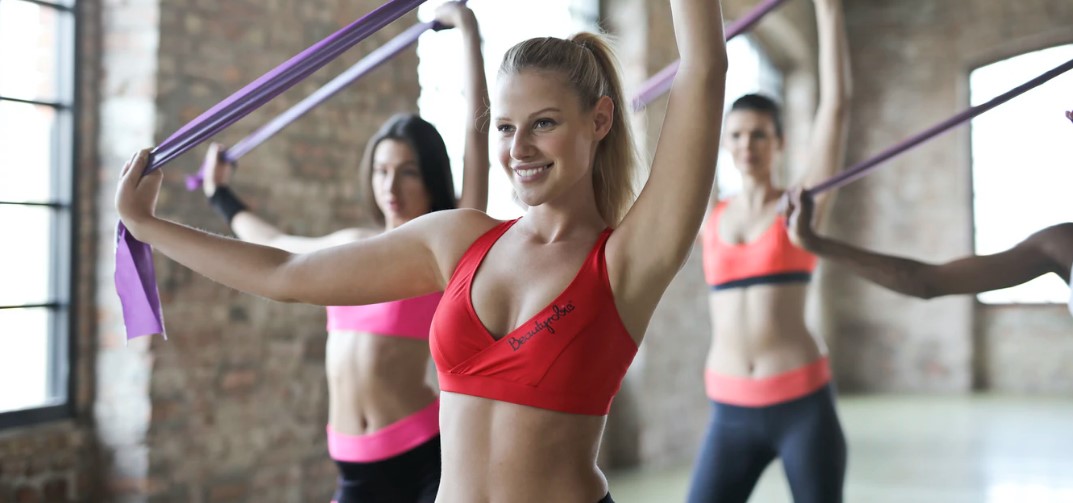Did you know that constant breast bounce can cause them to sag in the long run? This is because the breast ligaments get damaged if the breasts are not adequately supported over time. This means you must wear a properly fitting sports bra to prevent your breasts from drooping.
Getting a properly fitting sports bra is a common problem that most women face. Primarily due to lack of knowledge regarding sports bra measuring. Or the right bra type for different exercise activities. The sizing of clothing also varies from manufacturer to manufacturer.
You also have to take into consideration the fact that breast size can change from time to time. This could be due to weight gain, pregnancy, breastfeeding, hormonal changes during the menstrual cycle, menopause, and water retention due to higher carb intake. Keep reading to learn how to fit a sports bra.
Finding the Right Sports Bra Size
Fortunately, it is easy to find a sports bra size chart online or when shopping for a sports bra. If you are unsure of the correct sports bra size to select, you may ask the store attendant to assist you. If you are online shopping, you may need to measure yourself to ensure you buy the correct size.
How to Measure Yourself
Start by measuring your rib cage just beneath your bust. Then round off the size to the nearest inch either upwards or downwards. If your extra inch is above the quarter-inch mark, then round it upwards. Note this figure down, so you do not forget it.
Next, you need to figure out your band size based on your rib cage measurement. Use the chart below to determine what your band size.
| Rib Cage Measurement | Band Size |
| 25″ – 27″ | 30 |
| 27″ – 29″ | 32 |
| 29″ – 31″ | 34 |
| 31″ – 33″ | 36 |
| 33″ – 35″ | 38 |
| 35″ – 37″ | 40 |
| 37″ – 39″ | 42 |
| 39″ – 41″ | 44 |
The next step is to figure out your cup size. First, you need to measure the fullest part of your bust. Use a tape measure to measure the width of your bust.
This is typically the circumference of your chest area, specifically along the nipple region. Round off the figure as you did with the previous measurement.
Then subtract the rib cage measurement from the bust measurement size. The resulting figure is your cup size. Use the chart below to figure out your cup size.
| Bust Size Minus Rib Cage Size | Your Cup Size |
| 3″ | AA |
| 4″ | A |
| 5″ | B |
| 6″ | C |
| 7″ | D |
| 8″ | DD |
| 9″ | E |
| 10″ | F |
Measurement guidelines provided by Brooks Running
If you have a bust measurement of 40 inches and a rib cage measurement of 34 inches, the difference would be 6 inches, which means your cup size is a C cup.
Check this bra size calculator if you want to convert your readings into size faster.
How to Make Sure Your Bra Fits Perfectly
Now that you have understood the sports bra fitting guide, here are vital tips to ensure you are comfortable in your sports bra, which plays a significant role in enabling you to exercise without any breast-related encumbrance.
-
Band Size Matters
This is the most crucial element when it comes to a properly fitting bra. As it primarily holds your breast in place, especially if you have a larger bust. Think of it as wearing a regular bra with an expanded bra that leaves a space. This will make carrying out your day to day tasks extremely uncomfortable.
Ensure your band does not leave any space between the band and the rib cage. Ideally, you should not be able to insert more than two fingers without stretching the band. Also, ensure that the band sits parallel all round if it is lifted in the back, then it is too big.
For band size adjustment, buy a sports bra with a hook and closure system to enable you to customize the fit depending on the breast support needs. Also, look into getting a sports bra with a thicker band for extra support.
-
Straps
The same two-finger fit mentioned above applies to the straps. If you can insert more than two fingers with ease, then the straps are too loose. Buy a sports bra with adjustable straps to allow you to customize the fit depending on the needed compression level or the breast size changes.
You can also opt for thicker straps if you have a larger bust as they offer more support.
-
Cup Size
Ensure that the cups are form-fitting to ensure your breast is supported correctly. This will ensure that you are comfortable. Look for full coverage cups if you have large breasts to prevent your breasts from bouncing as you exercise.
-
Support Type
If shopping online, ensure the sports bra offers proper support before you buy it. If you shop online, do not hesitate to return a newly purchased sports bra if it does not provide the needed support. Unlike other clothing pieces, you cannot settle when it comes to sports bras. They are essential for maintaining your breast firmness.
Matching Sports Bra To Your Sporting Activity
Different sports intensities need different types of sports bras. For more intense sports activities, it would be great to wear sports bras with a tighter fit while you can get away with less compressing sports bras for less severe sporting activities.
The two main high-intensity sports bra options are encapsulation sports bras and compression sports bras. An encapsulation sports bra supports each breast individually while a compression bra holds both breasts in place by compressing them against the chest.
You can also get a hybrid encapsulation and compression sports bra that supports both breasts individually while compressing them against your rib cage. All the above sports bras are great for medium to high impact exercises.
For low impact exercises such as walking yoga or strength training, you can wear little support bras with narrow straps and bands. They tend to have minimal compression and are best for smaller breast cups, precisely size A or B.
For medium-impact exercises like hiking, skiing, or cycling, you can wear medium support sports bras with a slightly wider band and straps capable of restricting breast movement. You can opt for a hybrid encapsulation and compression bra.
High-impact exercises such as running, mountain biking, boxing, dancing, and high-intensity workouts, wear high support bras. This would have wider bands and adjustable straps; they are mainly meant for larger D cup sizes and above. The ideal support, in this case, would be a full compression bra for maximum support.
Pullover designs are acceptable for low- and medium-support sports bras, whereas high-impact bras will require a hook and closure design bra for a customizable fit in case of breast size change in the course of the sports bra life.
Crisscross, Tanktop, Racerback – Which is Which?
Crisscross
As the name suggests, this is a sports bra with an “X” design at the back. It is designed with fashion in mind instead of support. This strap design is typically seen in low support bras for smaller cup sizes.
Tank Top
This is the most common strap design in the sports bra. It is commonly found in sports bras with adjustable straps. The tank top design is used in low, medium, and high support bras. Some of the adjustable straps can even be adjusted to a crisscross design.
Racerback
These straps form a “Y” shape at the back of the sports bra. They offer a medium to high support and are best for medium and high impact sports, respectively. They are commonly found in compression sports bras.
Conclusion
In summary, ensure you consider other factors when shopping for a sports bra, aside from the bra size chart, like the type of material. In possible opt for a sports bra made from a moisture-wicking material. You should also consider whether you want to wear a sports bra with an underwire or not.

